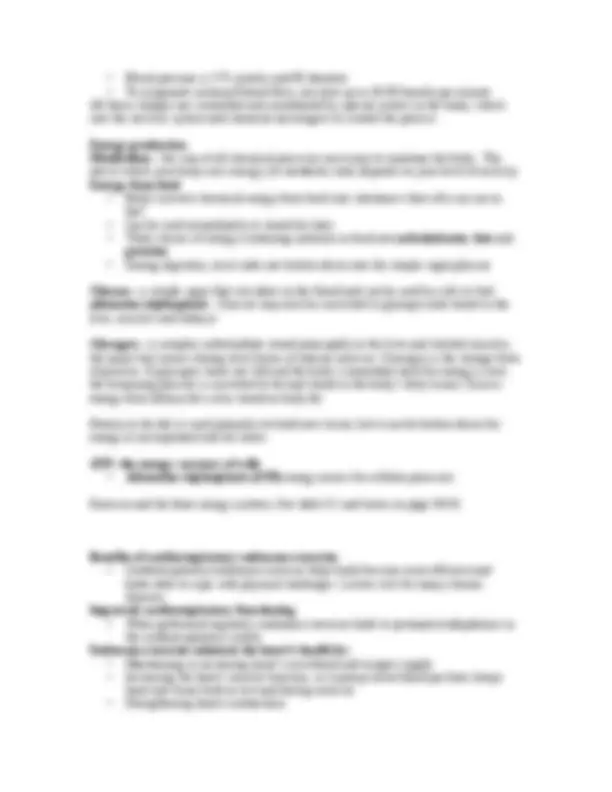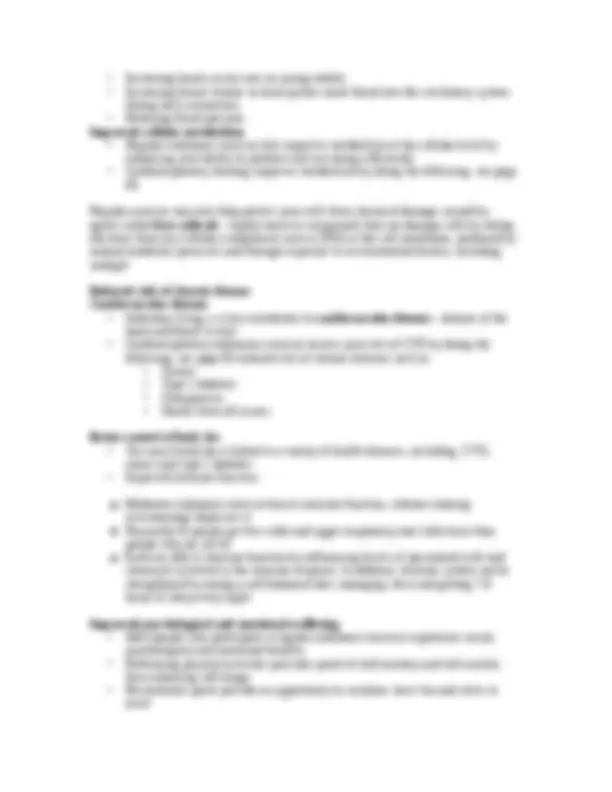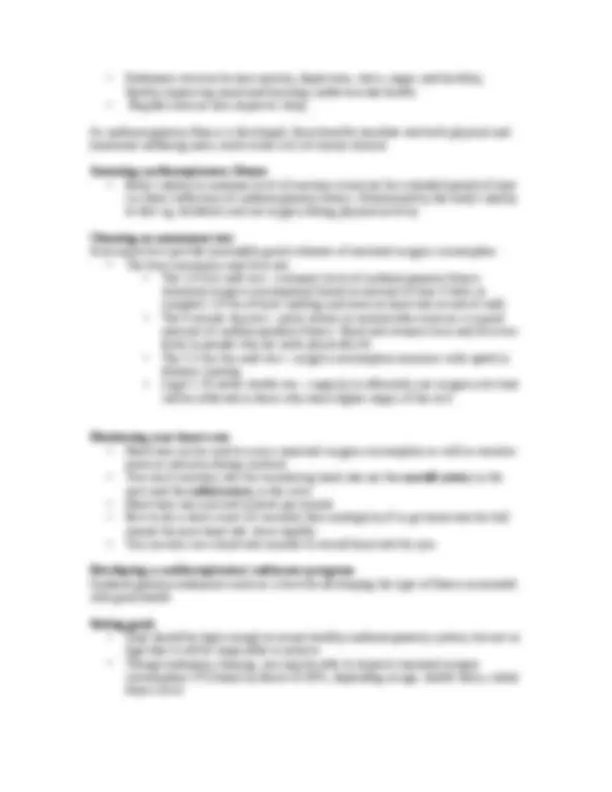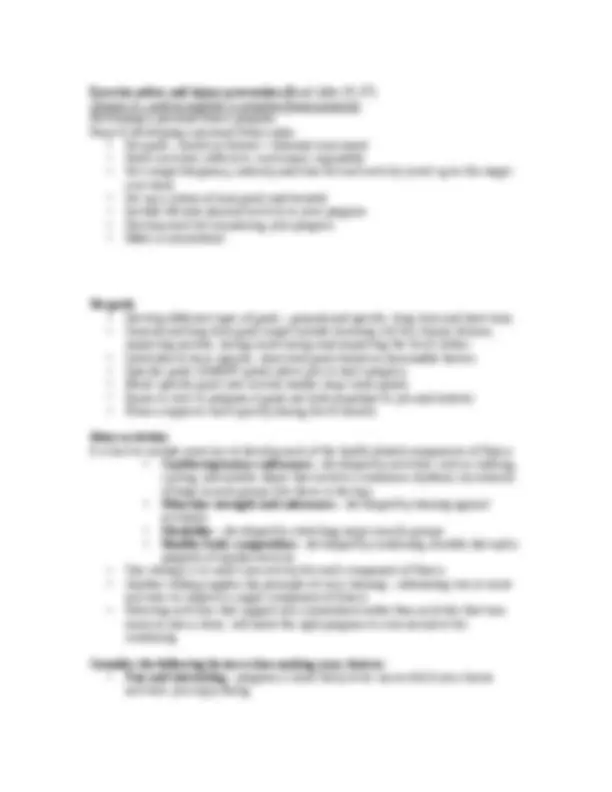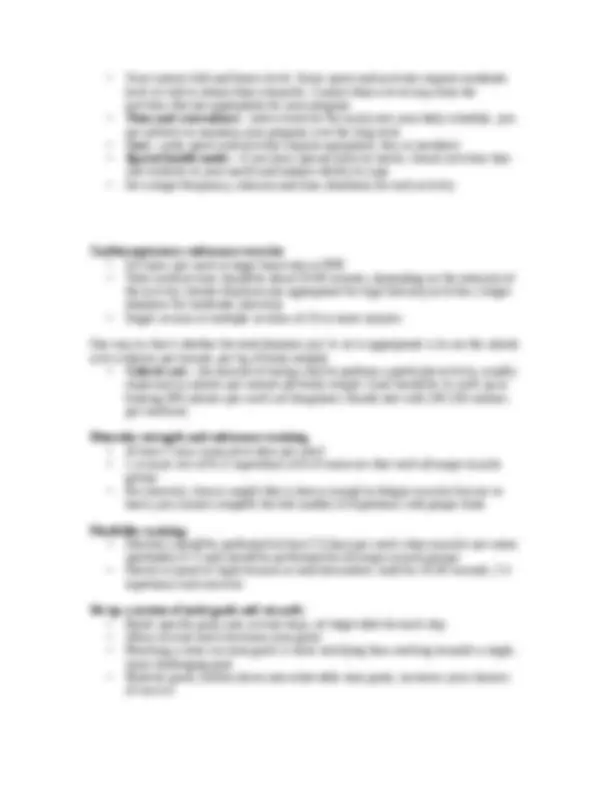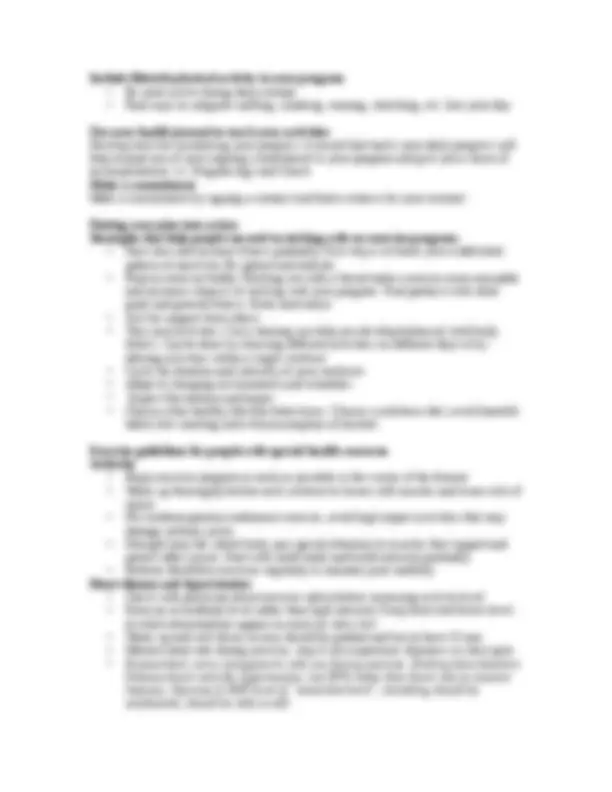Download FUNDAMENTALS OF HEALTH AND PHYSICAL ACTIVITY and more Study notes Physical Activity and Sport Sciences in PDF only on Docsity!
Chapter 3:
The cardiorespiratory system
- The cardiorespiratory system consists of the heart, the blood vessels and the respiratory system
- (^) It also picks up and transports oxygen, nutrients and other key substances to the organs and tissues that need them; it also picks up waste products and carries them to where they can be used or expelled The heart
- Four-chambered, fist sized muscle located beneath the ribs under the sternum
- Its role is to pump oxygen-poor blood to the lungs and oxygenated blood to the rest of the body
- Blood travels through two separate circulatory systems:
- The right side pumps blood to the lungs in what is called pulmonary circulation. The part of the circulatory system that moves blood between the heart and the lungs; controlled by the right side of the heart
- The left side pumps blood through the rest of the body in systematic circulation. The part of the circulatory system that moves blood between the heart and the rest of the body; controlled by the left side
Steps describing the path of blood through the cardiorespiratory system: page 56
Atria – the two upper chambers of the heart in which blood collects before passing to the ventricles; also called auricles
Venae cavae – the large veins through which blood is returned to the right atrium of the heart
Ventricles – the two lower chambers of the heart from which blood flows through arteries to the lungs and other parts of the body
Aorta – the large artery that receives blood from the left ventricle and distributes it to the body
Blood pressure
- (^) The force exerted by the blood on the walls of the blood vessels; created by pumping action of the heart. Blood pressure increases during systole and decreases during diastole
- Period of the hearts contraction is called systole. During systole, atria contract first, pumping blood into the ventricles; the ventricles contract, pumping blood into the lungs and body
- The period of relaxation is called diastole
- Normal systolic blood pressure for a young, healthy male is approx. 120 mm Hg; diastole blood pressure is approx 80 mm Hg (women 10-20 mm Hg below men)
- Blood pressure is higher in taller individuals
- (^) Blood pressure is measured using a sphygmomanometer
- Heart beat (the split second sequence of contractions of the hearts four chambers) is controlled by nerve impulses
The blood vessels
Blood vessel are classified by size and function
- Veins – vessels that carry blood to the heart
- Arteries – vessels that carry blood away from the heart
- (^) Veins have thin wall; arteries have thick elastic walls that enable them to expand and relax with the volume of blood being pumped through them
- Capillaries – very small blood vessels that distribute blood to all parts of the body Capillaries deliver oxygen and nutrient rich blood to the tissues and pass on oxygen poor, waste carrying blood Two large vessels, the right and left coronary arteries, branch off the aorta and supply the heart muscle with oxygenated blood. Blockage of this artery is the leading cause of heart attack
The respiratory system
- (^) Respiratory system – the lungs, air passages, and breathing muscles; supplies oxygen to the body and carries off carbon dioxide
- Air passes through lungs due to contraction and relaxation of the diaphragm and rib muscles
- The lungs expand and contract about 12-20 times a minute
- Alveoli – tiny air sacs in the lungs through whose walls gases such as oxygen and carbon dioxide diffuse in and out of blood. Carbon dioxide passes from blood cells into the alveoli, where it is carried up and out of the lungs (exhaled)
- Oxygen from inhaled air is passed from the alveoli into blood cells; returned to the heart and pumped throughout the body. Oxygen is an important part of the body’s energy producing system, so the cardiorespiratory systems ability to pick up and deliver oxygen is critical for the functioning of the body
The cardiorespiratory system at rest and during exercise
- At rest and light activity, cardiorespiratory system functions at a fairly steady pace
- Heart beats about 50-90 beats per minute
- Take about 12-20 breaths per minute
- (^) Blood pressure is 110 systolic and 70 diastolic (measured in millimeters of mercury)
- Cardiac output is 4.5-6 liters per minute
- Blood distributed to muscles is about 15-20% During exercise, demand on cardiorespiratory system increase. Body cells, particularly working muscles need to obtain more oxygen and fuel to eliminate more waste products.
- Heart rate increases, up to 170-210 beats per minute
- Hearts stroke volume (the amount of blood the heart circulates with each beat) increases
- Cardiac output increases to 18-23 liters per minute. Cardiac output – the amount of blood pumped by the heart each minute; function of heart rate and stoke volume (the amount of blood pumped during each beat
- Blood flow changes, as much as 85-90% of blood may be delivered to working muscles
- Increasing hearts cavity size (in young adults)
- Increasing blood volume so heart pushes more blood into the circulatory system during each contraction
- Reducing blood pressure Improved cellular metabolism
- Regular endurance exercise also improves metabolism at the cellular level by enhancing your ability to produce and use energy efficiently
- Cardiorespiratory training improves metabolism by doing the following: see page 63
Regular exercise may also help protect your cells from chemical damage caused by agents called free radicals – highly reactive compounds that can damage cells by taking electrons from key cellular components such as DNA or the cell membrane; produced by normal metabolic processes and through exposure to environmental factors, including sunlight
Reduced risk of chronic disease Cardiovascular disease
- Sedentary living is a key contributor to cardiovascular disease – disease of the heart and blood vessels
- Cardiorespiratory endurance exercise lowers your risk of CVD by doing the following: see page 63 reduced risk of chronic diseases such as: - Cancer - Type 2 diabetes - (^) Osteoporosis - Deaths from all causes
Better control of body fat
- Too much body fat is linked to a variety of health diseases, including, CVD, cancer and type 2 diabetes
- Improved immune function
▲ Moderate endurance exercise boosts immune function, whereas training (overtraining) depresses it ▲ (^) Physically fit people get few colds and upper respiratory tract infections than people who are not fit ▲ Exercise affects immune function by influencing levels of specialized cells and chemicals involved in the immune response. In addition, immune system can be strengthened by eating a well balanced diet, managing stress and getting 7- hours of sleep every night
Improved psychological and emotional wellbeing
- Most people who participate in regular endurance exercise experience social, psychological and emotional benefits
- (^) Performing physical activities provides proof of skill mastery and self control, thus enhancing self image
- Recreational sports provide an opportunity to socialize, have fun and strive to excel
- Endurance exercise lessens anxiety, depression, stress, anger, and hostility, thereby improving mood and boosting cardiovascular health.
- Regular exercise also improves sleep.
As cardiorespiratory fitness is developed, these benefits translate into both physical and emotional wellbeing and a much lower risk of chronic disease
Assessing cardiorespiratory fitness
- Body’s ability to maintain level of exertion (exercise) for extended period of time is a direct reflection of cardiorespiratory fitness. Determined by the body’s ability to take up, distribute and use oxygen during physical activity
Choosing an assessment test Assessment test provide reasonably good estimates of maximal oxygen consumption
- (^) The four commonly used tests are:
- The 1.6 Km walk test – estimates level of cardiorespiratory fitness (maximal oxygen consumption) based on amount of time it takes to complete 1.6 km of brisk walking and exercise heart rate at end of walk
- The 3 minute step test – pulse returns to normal after exercise is a good measure of cardiorespiratory fitness. Heart rate remains lows and recovers faster in people who are more physically fit
- The 2.4 km run-walk test – oxygen consumption increases with speed in distance running
- Leger’s 20 meter shuttle run – capacity to efficiently use oxygen over time will be reflected in those who reach higher stages of this test
Monitoring your heart rate
- Heart rate can be used to assess maximal oxygen consumption as well as monitor exercise intensity during workout
- Two most common sites for monitoring heart rate are the carotid artery in the neck and the radial artery in the wrist
- Heart rates are assessed in beats per minute
- Best to do a short count (10 seconds) then multiply by 6 to get heart rate for full minute because heart rate slows rapidly
- You can also use a heart rate monitor to record heart rate for you
Developing a cardiorespiratory endurance program Cardiorespiratory endurance exercise is best for developing the type of fitness associated with good health
Setting goals
- Goal should be high enough to ensure healthy cardiorespiratory system, but not so high that it will be impossible to achieve
- (^) Though endurance training, you may be able to improve maximal oxygen consumption (VO2max) by about 10-30%, depending on age, health status, initial fitness level
Type of activity Cardiorespiratory endurance exercises include activities that involve rhythmic use of large muscle groups for an extended period of time, such as jogging, walking, cycling, aerobic dancing and swimming
- Having fun is a strong motivator as well as exercising with a friend
Warming up and cooling down
- Warming up (5-10 min)
- Muscles work better when warmed up
- Increase heart rate gradually, raise body temperature
- Redirect blood flow to working muscles
- Spread synovial fluid within joints
- Cooling down (5-10 min)
- (^) Blood flow and respiration return to normal
- Relaxation for muscles
Building cardiorespiratory fitness
- Rate of improvement will depend on your age, health status, initial level of fitness and motivation
- Fitness improves when you overload your body
- For the initial phase of you program, which may last 3-6 weeks, exercise at the low end of your target heart rate zone/ 3-4 days per week...12-15 reps if unfit, 20 if sedentary but healthy and 30-40 minutes if experienced exerciser
- (^) The next phase if the improvement phase
- Lasts 4 to 6 months
- Slowly and gradually increase amount of overload until you reach target level of fitness
- Increase duration 5-10 minutes every 2-3 weeks/ 3-5 days per week, middle to upper end of target HR zone, 25-40 minute duration
Signs of too rapid progession in overload include muscles aches and pains, lack of usual interest in exercise, extreme fatigue, and inability to complete a workout
Maintaining cardiorespiratory fitness Continue to exercise at the same intensity on 3 non-consecutive days per week If you have to stop, start the program again at a lower level
Cross-training maintains motivation and reduces injury (+ expands specific and general physical benefits and activity skills)
- Cross-training – alternating two or more activities to improve a single component of fitness
- Interval training – adding relatively more intense training sessions to less intense sessions. Each more intense repetition should be followed by rest period of an equal time length
- Fartlek training – incorporating relatively more intense training into a less intense session. Using existing environmental conditions (hills and stairs, and plan the training session to include them on the running/jogging route
Exercise safety and injury prevention ( Read slides 31-37) Chapter 9 – putting together a complete fitness program Developing a personal fitness program
Steps to developing a personal fitness plan
- Set goals – based on formal + informal assessment
- Select activities (effective, convenient, enjoyable)
- Set a target frequency, intensity and time for each activity (work up to this target over time)
- Set up a system of mini goals and rewards
- Include lifestyle physical activity in your program
- Develop tools for monitoring your progress
- Make a commitment
Set goals
- Develop different types of goals – general and specific, long term and short term
- General and long term goals might include lowering risk for chronic disease, improving posture, having more energy and improving the fit of clothes
- Good idea to have specific, short term goals based on measurable factors
- Specific goals (SMART goals) allow you to track progress
- Break specific goals into several smaller steps (mini-goals)
- (^) Easier to stick to program if goals are both important to you and realistic
- Fitness improves most quickly during first 6 months
Select activities It is best to include exercises to develop each of the health related components of fitness
- Cardiorespiratory endurance – developed by activities such as walking, cycling, and aerobic dance that involves continuous rhythmic movements of large muscle groups like those in the legs
- Muscular strength and endurance – developed by training against resistance
- (^) Flexibility – developed by stretching major muscle groups
- Healthy body composition – developed by combining sensible diet and a program of regular exercise
- One strategy is to select one activity for each component of fitness
- Another strategy applies the principle of cross training – alternating two or more activities to improve a single component of fitness
- Selecting activities that support you commitment rather than activities that turn exercise into a chore, will make the right program its own incentive for continuing
Consider the following factors when making your choices:
- Fun and interesting – program is more likely to be successful if you choose activities you enjoy doing
Include lifestyle physical activity in your program
- Be more active during daily routine
- Find ways to integrate walking, climbing, running, stretching, etc. Into your day
Use your health journal to track your activities Develop tools for monitoring your progress. A record that tracks your daily progress will help remind you of your ongoing commitment to your program and give you a sense of accomplishment. i.e. Program logs and Charts Make a commitment Make a commitment by signing a contract and find a witness for your contract
Putting your plan into action Strategies that help people succeed in sticking with an exercise program:
- Start slow and increase fitness gradually. First step is to break your established pattern of inactivity. Be patient and realistic
- Find an exercise buddy. Working out with a friend makes exercise more enjoyable and increases chances of sticking with your program. Find partners with same goals and general fitness. Extra motivation
- Ask for support from others
- Vary your activities. Cross training can help you develop balanced, total body fitness. Can be done by choosing different activities on different days or by altering activities within a single workout
- Cycle the duration and intensity of your workouts
- Adapt to changing environments and schedules
- (^) Expect fluctuations and lapses
- Choose other healthy lifestyle behaviours. Choose a nutritious diet, avoid harmful habits like smoking and overconsumption of alcohol
Exercise guidelines for people with special health concerns Arthritis
- Begin exercise program as early as possible in the course of the disease
- Warm up thoroughly before each workout to loosen still muscles and lower risk of injury
- For cardiorespiratory endurance exercise, avoid high impact activities that may damage arthritic joints
- Strength train the whole body; pay special attention to muscles that support and protect affect joints. Start with small loads and build intensity gradually
- Perform flexibility exercises regularly to maintain joint mobility Heart disease and hypertension
- Check with physician about exercise safety before increasing activity level
- Exercise at moderate level rather than high intensity. Keep heart rate below level at which abnormalities appear on exercise stress test
- Warm up and cool down session should be gradual and last at least 10 min
- Monitor heart rate during exercise, stop if you experience dizziness or chest pain
- (^) If prescribed, carry nitroglycerin with you during exercise. If taking beta-blockers (reduces heart rate) for hypertension, use RPE rather than heart rate to monitor intensity. Exercise at RPE level of “somewhat hard”; breathing should be unlaboured, should be able to talk
- Don’t hold breath when exercising (could cause steep increase in blood pressure)
- Take special care during weight training; don’t lift extremely heavy loads. Exhale during exertion phase of lifts
- Increase exercise frequency, intensity and time very gradually
Obesity
- For max benefit and min risk, begin by choosing low-to-moderate intensity activities. Increase intensity slowly as your fitness improves
- People who want to lose weight or maintain weight loss should exercise moderately 60 or more mins every day
- Choose non or low weight bearing activities such as swimming, water exercise, cycling or walking. Low impact activities are less likely to lead to joint problems or injuries
- Stay alert for heart related problems during exercise
- (^) Ease into exercise program and increase overload gradually. Increase time and frequency of exercise before increasing intensity
- Include strength training in fitness program to build or maintain muscle mass
- Try to include as much lifestyle physical activity in daily routine as possible
Exercise guidelines for life stages Pregnant women should consider these guidelines when exercising:
- See physician about possible modifications needed for particular pregnancy
- Continue mild to moderate exercise routines (100-160 beats per minute) at least 3 times a week. Avoid exercising vigorously or to exhaustion, especially in 3rd trimester
- Monitor intensity by assessing how you feel rather than heart rate; RPE levels of 11-13 are appropriate
- Favor non or low weight bearing exercises such as swimming or cycling over weight bearing exercises, which can carry increased risk of injury
- Avoid exercise in supine position – lying on your back – after first trimester. Avoid prolonged periods of motionless standing
- Avoid exercise that could cause loss of balance, especially in third trimester, and exercise that might injure the abdomen, stress the joints or carry risk of falling
- Avoid activities involving extremes in barometric pressure, such as scuba diving and mountain climbing
- Especially during first trimester, drink plenty of fluids and exercise in well ventilated areas to avoid heat stress
- 3-5 sets of kegel exercises daily. Involve tightening the muscles of the pelvic floor for 5-15 seconds. Kegel exercise are thought to help prevent incontinence (involuntary loss of urine) and speed recovery after giving birth. After giving birth, resume prepregnancy exercise routines gradually, depending on how you feel
- Older adults
General exercise principles are the same as for younger people, but some specific guidelines apply:
- Include three basic types of exercise – resistance, endurance and flexibility

